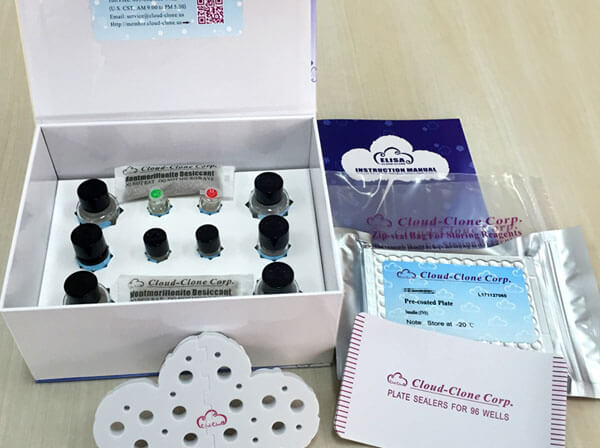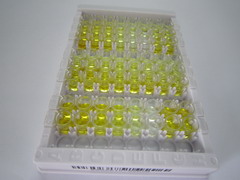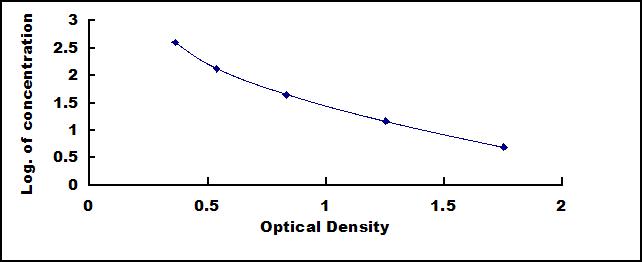ELISA Kit for Hyaluronic Acid (HA) 

Hyaluronan; Hyaluronate
- UOM
- FOB US$ 557.00 US$ 796.00 US$ 3,580.00 US$ 6,763.00 US$ 55,692.00
- Quantity
Overview
Properties
- Product No.CEA182Ge
- Organism SpeciesPan-species (General) Same name, Different species.
- ApplicationsEnzyme-linked immunosorbent assay for Antigen Detection.
Research use only - DownloadInstruction Manual
- CategoryTumor immunityHepatology
Sign into your account
Share a new citation as an author
Upload your experimental result
Review

Contact us
Please fill in the blank.
Recovery
Matrices listed below were spiked with certain level of Hyaluronic Acid (HA) and the recovery rates were calculated by comparing the measured value to the expected amount of Hyaluronic Acid (HA) in samples.
| Matrix | Recovery range (%) | Average(%) |
| serum(n=5) | 96-105 | 101 |
| EDTA plasma(n=5) | 80-93 | 85 |
| heparin plasma(n=5) | 92-101 | 96 |
Precision
Intra-assay Precision (Precision within an assay): 3 samples with low, middle and high level Hyaluronic Acid (HA) were tested 20 times on one plate, respectively.
Inter-assay Precision (Precision between assays): 3 samples with low, middle and high level Hyaluronic Acid (HA) were tested on 3 different plates, 8 replicates in each plate.
CV(%) = SD/meanX100
Intra-Assay: CV<10%
Inter-Assay: CV<12%
Linearity
The linearity of the kit was assayed by testing samples spiked with appropriate concentration of Hyaluronic Acid (HA) and their serial dilutions. The results were demonstrated by the percentage of calculated concentration to the expected.
| Sample | 1:2 | 1:4 | 1:8 | 1:16 |
| serum(n=5) | 86-101% | 95-104% | 79-88% | 84-98% |
| EDTA plasma(n=5) | 79-97% | 78-104% | 87-105% | 89-103% |
| heparin plasma(n=5) | 96-105% | 89-97% | 94-105% | 97-104% |
Stability
The stability of kit is determined by the loss rate of activity. The loss rate of this kit is less than 5% within the expiration date under appropriate storage condition.
To minimize extra influence on the performance, operation procedures and lab conditions, especially room temperature, air humidity, incubator temperature should be strictly controlled. It is also strongly suggested that the whole assay is performed by the same operator from the beginning to the end.
Reagents and materials provided
| Reagents | Quantity | Reagents | Quantity |
| Pre-coated, ready to use 96-well strip plate | 1 | Plate sealer for 96 wells | 4 |
| Standard | 2 | Standard Diluent | 1×20mL |
| Detection Reagent A | 1×120µL | Assay Diluent A | 1×12mL |
| Detection Reagent B | 1×120µL | Assay Diluent B | 1×12mL |
| TMB Substrate | 1×9mL | Stop Solution | 1×6mL |
| Wash Buffer (30 × concentrate) | 1×20mL | Instruction manual | 1 |
Assay procedure summary
1. Prepare all reagents, samples and standards;
2. Add 50µL standard or sample to each well.
And then add 50µL prepared Detection Reagent A immediately.
Shake and mix. Incubate 1 hour at 37°C;
3. Aspirate and wash 3 times;
4. Add 100µL prepared Detection Reagent B. Incubate 30 minutes at 37°C;
5. Aspirate and wash 5 times;
6. Add 90µL Substrate Solution. Incubate 10-20 minutes at 37°C;
7. Add 50µL Stop Solution. Read at 450 nm immediately.

Test principle
This assay employs the competitive inhibition enzyme immunoassay technique. An antibody specific to hyaluronic acid has been pre-coated onto a microplate. A competitive inhibition reaction is launched between biotin labeled hyaluronic acid and unlabeled hyaluronic acid (Standards or samples) with the pre-coated antibody specific to hyaluronic acid. After incubation the unbound conjugate is washed off. Next, avidin conjugated to Horseradish Peroxidase (HRP) is added to each microplate well and incubated. The amount of bound HRP conjugate is reverse proportional to the concentration of hyaluronic acid in the sample. After addition of the substrate solution, the intensity of color developed is reverse proportional to the concentration of hyaluronic acid in the sample.
Giveaways
Increment services
Citations
- Hemorrhagic Fever Caused by a Novel Bunyavirus in China: Pathogenesis and Correlates of Fatal OutcomeOxfordJournals: source
- Alveolar fluid in acute respiratory distress syndrome promotes fibroblast migration: Role of platelet-derived growth factor pathway*PubMed: 22713216
- Age effects on extracellular matrix production of vocal fold scar fibroblasts in ratsPubmed: 24077847
- Vocal Fold Fibroblast Response to Growth Factor Treatment is Age Dependent: Results From an In Vitro StudyScienceDirect: S0892199713002415
- Resveratrol inhibits ovarian cancer cell adhesion to peritoneal mesothelium in vitro by modulating the production of α5β1 integrins and hyaluronic acidPubmed:24995580
- Establishing principles of macromolecular crowding for in vitro fibrosis research of the vocal fold lamina propriaPubmed:25545625
- Pituitary tumor transforming gene as a novel regulatory factor of liver fibrosisPubMed: 25936962
- Camel Milk: Potential Utility as an Adjunctive Therapy to Peg-IFN/RBV in HCV-5 Infected Patients in EgyptPubMed: 26492131
- Study of Some Serum Biochemical Markers of Liver Fibrosis in Patients with Chronic HCVISSN 2575-7733
- A putative Chondroprotective role for IL-1β and MPO in herbal treatment of experimental osteoarthritispubmed:29166937
- Polycomb group proteins: Novel molecules associated with ultraviolet A-induced photoaging of human skin.pubmed:28962194
- The effect of aerobic walking and lower body resistance exercise on serum COMP and hyaluronan, in both males and femalesPubmed:29536174
- Evaluation of antifibrotic effects of coffee and cocoa extracts in rats with thioacetamide-induced fibrosis10.1007:s00217-018-3119-z
- Juvenile Ovine Ex Vivo Larynges: Phonatory, Histologic, and Micro CT Based Anatomic Analyses
- Selected elements of extracellular matrix of the skin in diabetes and insulin resistancePubmed: 31146169
- Strain-Dependent Porcine Circovirus Type 2 (PCV2) Entry and Replication in T-LymphoblastsPubmed: 31480752
- Betulin attenuated liver damage by prevention of hepatic mitochondrial dysfunction in rats with alcoholic steatohepatitisPubmed: 31619044
- Damage-Associated Molecular Patterns and Th-Cell-Related Cytokines Released after Progressive EffortPubmed: 32210109
- iTRAQ-based analysis for the identification of MARCH8 targets in human esophageal squamous cell carcinoma33540066
- An exploratory study to investigate the association between age, physical activity, femoral trochlear cartilage thickness and biomarkers of tissue metabolism in?¡33713200
- Trimethylamine N‐oxide exacerbates acetaminophen‐induced liver injury by interfering with macrophage‐mediated liver regeneration34459512
- Comparative studies on the effect of pig adipose-derived stem cells (pASCs) preconditioned with hypoxia or normoxia on skin wound healing in micePubmed:35718003
- Bicyclol ameliorates advanced liver diseases in murine models via inhibiting the IL-6/STAT3 signaling pathwayPubmed:35658240
- Novel multifunctional delivery system for chondrocytes and articular cartilage based on carbon quantum dots











